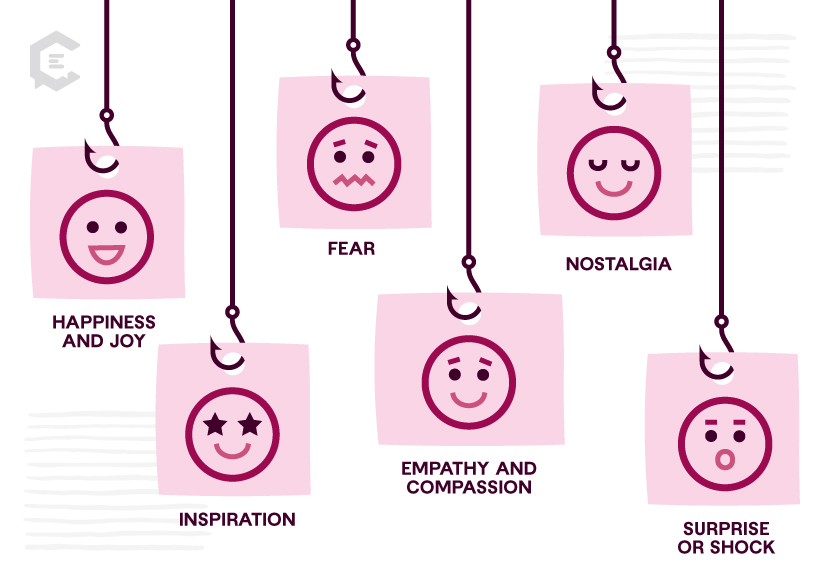Emotions play a crucial role in marketing.
As humans, we rely heavily on our feelings to make decisions. If product A and product B are completely identical, emotion could be what sways a customer to choose one or the other.
Emotions can:
- Differentiate one brand from another in a competitive market.
- Build trust and foster long-term loyalty.
- Create memories.
- Influence their attitudes, beliefs, and behaviors.
If you’re struggling to find an emotional hook for your marketing, we’ve compiled some tips to help.
The Power of Emotion in Marketing
Understanding the psychology behind emotional responses can help marketers work better. Emotional intelligence can help engage audiences, create emotional connections, and influence decision-making.
Neurologically, emotional responses involve the activation of brain regions associated with emotions. The amygdala plays an important role in emotional processing. Emotions can influence attention, memory, and decision-making processes — shaping consumer behavior.
Some other psychological factors to consider include:
- Emotional triggers: Emotional responses in marketing are often triggered by various stimuli. This could be compelling storytelling, relatable situations, humor, fear, joy, or nostalgia. These triggers can influence their perception of the brand or product.
- Cognitive appraisal: This is a process of evaluating the relevance and significance of the information. Emotions occur because of this process. Cognitive appraisal helps determine if the content is positive or negative, arousing or calming, and relevant or irrelevant.
- Emotional associations: Emotions are deeply connected to personal experiences and memories. Marketing content that evokes emotions can create associations between the brand and positive emotional states.
- Persuasion and influence: Emotional responses to marketing content causes cognitive and rational processes. Emotionally charged content can lead individuals to make purchasing decisions or take specific actions.
- Social influence and social proof: People often look to others for guidance on how to feel or react. In marketing, social proof, testimonials, and peer endorsements can create emotional responses. They tap into the desire for social acceptance and belonging.
- Emotional contagion: Emotions can spread from one person to another. When marketing content elicits strong emotional responses, it can trigger similar emotional experiences in others. Emotional contagion can contribute to the virality and shareability of content, amplifying its impact.
Different Types of Emotional Hooks
Marketers and advertisers can use a wide range of emotions. The emotions they trigger depend on their goals, audience, and the specific message they want to convey.
Happiness and joy
Emotions like happiness and joy are frequently used to create a positive association with a brand or product. The theory is that ads that evoke feelings of joy make consumers associate positive emotions with the brand. Similarly, marketers use excitement to build enthusiasm for a product or upcoming event.
Fear
Fear is a powerful emotion that can capture attention and drive action. Marketers may leverage fear to highlight potential risks or problems that their product or service can solve. This emotion is often employed in health, safety, and insurance-related advertisements.
Nostalgia
Nostalgia triggers sentimental feelings related to the past. Marketers use nostalgia to create a sense of familiarity and comfort. Using nostalgia can remind consumers of positive memories or associations.
Inspiration
Marketers may use inspiration to motivate and empower their audience. Through inspirational stories, marketers can inspire feelings of hope, ambition, and determination. These emotions encourage consumers to aspire to similar outcomes.
Empathy and compassion
Demonstrating empathy and compassion can create emotional connections with consumers. These ads may showcase real-life challenges, social causes, or acts of kindness. Such ads aim to evoke feelings of empathy and compassion, reinforcing the brand’s values and fostering goodwill.
Surprise or shock
Surprise and shock can capture attention and make an advertisement memorable. Unexpected or unconventional approaches can evoke surprise. That surprise creates a lasting impression — driving conversations about the brand or product.
6 Tips for Creating Emotionally Charged Content
Emotions are a powerful tool. Marketers can use emotions to build meaningful connections, foster understanding, and create positive experiences. Ones that align with your brand values and goals.
These tips can help you stand out and speak clearly to your audience.
Understand your target audience
Understanding your target audience’s needs, wants, and aspirations is essential. If you gain a deep understanding of your target audience’s hopes and desires needs, you can more easily speak to a consumer. Identify the emotions that resonate with them and align with their motivations.
For example, a banking institution could create content highlighting customer stories of achieving financial milestones.
Maybe it’s a video series of customers saving for their dream home through your financial planning services or securing a loan to attend college.
These stories will evoke powerful emotional responses and foster a deeper connection with both current and prospective customers, showcasing how your institution plays a vital role in their journey.
Tell stories
Storytelling is a powerful tool for evoking emotions. If you want to create emotional content, try to craft compelling narratives. You want to tell stories that connect with your audience on a personal level. Focus on authentic and relatable stories that reflect real-life experiences, challenges, or successes. Authenticity builds trust and emotional resonance.
Evoke emotions through imagery and music
Images, sounds, and language all impact emotions and emotional responses. Choose images, videos, and music that elicit the desired emotions. Pay attention to color schemes, composition, facial expressions, and soundtracks that align with the emotions you want to evoke.
Use metaphors and symbolism
Reading a report of facts and figures doesn’t evoke emotion. Telling stories through metaphors and symbolism can evoke deeper emotional responses. Cleverly use metaphors, visual cues, or symbolic representations to convey emotions or messages in a more subtle and memorable way.
Use humor
Humor can be a powerful emotional trigger when used appropriately. A funny story is more likely to stick than a droll report. Injecting humor into your advertising can create positive associations, build likability, and increase memorability. However, ensure that your humor aligns with your brand and resonates with your target audience.
Foster engagement and interaction
The key to emotional marketing is connection. You want to create opportunities for your audience to engage with your brand emotionally. It’s important to encourage participation, feedback, and sharing of personal stories. Incorporate interactive elements, contests, or social media campaigns that elicit emotional responses and promote user engagement.
Real-World Examples of Emotional Content
Here are three examples of real-world emotional content marketing campaigns:
Coca-Cola’s “Share a Coke” Campaign
The “Share a Coke” campaign aims to connect people. Instead of the Coca-Cola logo, bottles and cans featured popular names and terms like “Friend,” “Mom,” or “Love.” This campaign tapped into the emotions of personalization, nostalgia, and the joy of sharing a Coke with someone special.
Nike’s “Dream Crazy” Campaign
Nike’s “Dream Crazy” campaign featured former NFL quarterback Colin Kaepernick. The campaign evoked emotions of empowerment, inspiration, and social justice. It also sparked a significant amount of debate and controversy. Especially as it resonated with those who identified with Kaepernick’s message of standing up for what you believe in, pursuing your dreams, and overcoming adversity.
Always’ “Like a Girl” Campaign
Always, a feminine hygiene brand launched the “Like a Girl” campaign to challenge gender stereotypes and empower young girls. The campaign highlighted the negative connotations associated with the phrase “like a girl.” Always featured strong, confident girls challenging what it means to do something “like a girl.” The emotional content aimed to inspire girls to embrace their strengths.
Mastering Emotional Content in Your Marketing
Emotions influence our perceptions, choices, and behaviors.
Creating content that creates emotional responses can forge deep connections with an audience. Strong emotions make a brand or product memorable and relatable. By understanding and using emotions effectively, marketers can create meaningful experiences and drive customer actions.
If you’re not sure how to leverage emotions in your current content plan, ClearVoice can help. Book a content strategy session to jumpstart your next campaign.










